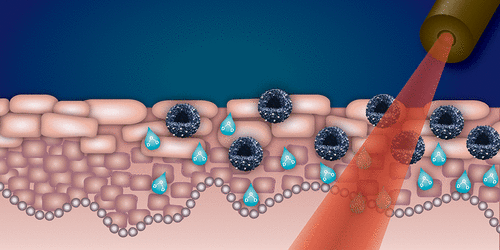当前位置:
X-MOL 学术
›
ACS Appl. Mater. Interfaces
›
论文详情
Our official English website, www.x-mol.net, welcomes your
feedback! (Note: you will need to create a separate account there.)
Polyglycerol-Based Thermoresponsive Nanocapsules Induce Skin Hydration and Serve as a Skin Penetration Enhancer.
ACS Applied Materials & Interfaces ( IF 8.3 ) Pub Date : 2020-06-10 , DOI: 10.1021/acsami.0c06874 Ernesto R Osorio-Blanco 1 , Fiorenza Rancan 2 , André Klossek 3 , Jan H Nissen 4 , Luisa Hoffmann 2 , Julian Bergueiro 1, 5 , Sebastian Riedel 4 , Annika Vogt 2 , Eckart Rühl 3 , Marcelo Calderón 1, 6, 7
ACS Applied Materials & Interfaces ( IF 8.3 ) Pub Date : 2020-06-10 , DOI: 10.1021/acsami.0c06874 Ernesto R Osorio-Blanco 1 , Fiorenza Rancan 2 , André Klossek 3 , Jan H Nissen 4 , Luisa Hoffmann 2 , Julian Bergueiro 1, 5 , Sebastian Riedel 4 , Annika Vogt 2 , Eckart Rühl 3 , Marcelo Calderón 1, 6, 7
Affiliation

|
The use of penetration enhancers (chemical or physical) has been proven to dramatically improve the penetration of therapeutics. Nevertheless, their use poses great risks, as they can lead to permanent damage of the skin, reduce its barrier efficiency, and result in the intrusion of harmful substances. Among the most used skin penetration enhancers, water is greatly accepted because skin quickly recovers from its exposure. Nanocapsules (NCs) represent a promising combination of the carrier system and penetration enhancer because their water-containing void combined with their polymer-based shell can be used to induce high local skin hydration, while simultaneously aiding the transport of drugs across the skin barrier. In this study, NCs were synthesized with a void core of 100 nm in diameter, a thermoresponsive shell based on different ratios of poly(N-isopropylacrylamide) and poly(N-isopropylmethacrylamide) as thermoresponsive polymers, and dendritic polyglycerol as a macromolecular cross-linker. These NCs can shrink or swell upon a thermal trigger, which was used to induce the release of the entrapped water in a controlled fashion. The interactions and effects of thermoresponsive NCs on the stratum corneum of excised human skin were investigated using fluorescence microscopy, high-resolution optical microscopy, and stimulated Raman spectromicroscopy. It could be observed that the thermoresponsive NCs increase the amount of deuterated water that penetrated into the viable epidermis. Moreover, NCs increased the skin penetration of a high-molecular weight dye (Atto Oxa12 NHS ester, MW = 835 g/mol) with respect to formulations in water or 30% DMSO, emphasizing the features of the NCs as a skin penetration enhancer.
中文翻译:

基于聚甘油的热敏纳米胶囊可诱导皮肤水合作用,并可用作皮肤渗透促进剂。
已证明使用渗透促进剂(化学或物理)可显着提高治疗剂的渗透性。然而,它们的使用带来了巨大的风险,因为它们可能导致皮肤的永久性损害,降低其屏障效率并导致有害物质的侵入。在最常用的皮肤渗透促进剂中,水被广泛接受是因为皮肤会从其暴露中迅速恢复。纳米胶囊(NCs)代表了载体系统和渗透促进剂的有前途的组合,因为它们的含水空隙与基于聚合物的外壳相结合可用于诱导高局部皮肤水合作用,同时帮助药物通过皮肤屏障运输。在这项研究中,合成了具有100 nm直径的空核的NC,N-异丙基丙烯酰胺)和聚(N-异丙基甲基丙烯酰胺)作为热敏性聚合物,树状聚甘油作为大分子交联剂。这些NC会在热触发时收缩或膨胀,该热触发被用来以受控的方式释放夹带的水。使用荧光显微镜,高分辨率光学显微镜和受激拉曼光谱显微镜研究了热响应性NCs对被切除的人皮肤角质层的相互作用和影响。可以观察到,热响应性NC增加了渗透到活表皮中的氘化水量。此外,相对于在水或30%DMSO中的制剂,NCs增加了高分子量染料(Atto Oxa12 NHS酯,MW = 835 g / mol)的皮肤渗透性,强调了NCs作为皮肤渗透促进剂的特征。
更新日期:2020-07-08
中文翻译:

基于聚甘油的热敏纳米胶囊可诱导皮肤水合作用,并可用作皮肤渗透促进剂。
已证明使用渗透促进剂(化学或物理)可显着提高治疗剂的渗透性。然而,它们的使用带来了巨大的风险,因为它们可能导致皮肤的永久性损害,降低其屏障效率并导致有害物质的侵入。在最常用的皮肤渗透促进剂中,水被广泛接受是因为皮肤会从其暴露中迅速恢复。纳米胶囊(NCs)代表了载体系统和渗透促进剂的有前途的组合,因为它们的含水空隙与基于聚合物的外壳相结合可用于诱导高局部皮肤水合作用,同时帮助药物通过皮肤屏障运输。在这项研究中,合成了具有100 nm直径的空核的NC,N-异丙基丙烯酰胺)和聚(N-异丙基甲基丙烯酰胺)作为热敏性聚合物,树状聚甘油作为大分子交联剂。这些NC会在热触发时收缩或膨胀,该热触发被用来以受控的方式释放夹带的水。使用荧光显微镜,高分辨率光学显微镜和受激拉曼光谱显微镜研究了热响应性NCs对被切除的人皮肤角质层的相互作用和影响。可以观察到,热响应性NC增加了渗透到活表皮中的氘化水量。此外,相对于在水或30%DMSO中的制剂,NCs增加了高分子量染料(Atto Oxa12 NHS酯,MW = 835 g / mol)的皮肤渗透性,强调了NCs作为皮肤渗透促进剂的特征。











































 京公网安备 11010802027423号
京公网安备 11010802027423号